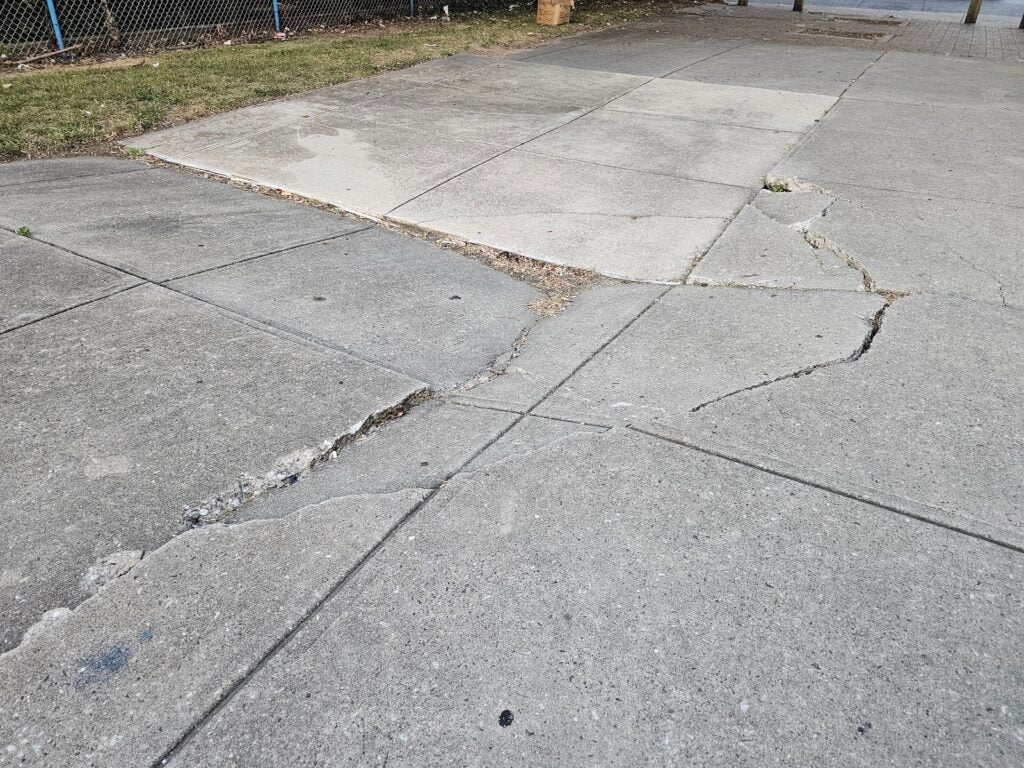Understanding Concrete Washout Risks
In today’s blog, here on our website, we are looking at pictures that show a case of differential settlement in concrete flat work or paving where there is a suppression or cave-in right in the middle of the area of the concrete paving. This is an unexpected type of failure.
There are many different types of concrete and masonry failures that are somewhat predictable. Some types of masonry and concrete failures can simply be expected especially when the concrete in masonry isn’t provided proper maintenance and care. The type of failure that we’re looking at today though is unfortunately unexpected and highly problematic. There could be several different factors that lead to the cause of this type of problem, but the vast majority of those probabilities of failure fit within two main categories.
The first main category is uneven compaction before preparing the subgrade for pouring of the concrete. The second most likely reason is washout underneath the area of concrete. In some cases, even after concrete has been poured, areas can experience excessive hydration or moisture which lead to the accumulation or even the flow of water.
If you look closely in the picture below, you may be able to notice that there is severe cracking and even downward deflection in the otherwise intended horizontal plane of this concrete paving.

In this particular case, you could also say that there’s a potential third cause. It could be that a very heavy vehicle or even a crane or heavy construction equipment set down an outrigger or a heavy bearing point on top of this concrete. However, a strong argument could be made that that alone is not an actual direct reason for the failure. Even in most cases when heavy vehicles are set on top of concrete, that alone is normally not sufficient pressure to break the concrete.
Particularly, typical and properly built concrete should be able to resist forces of that nature. This applies, specifically, if the concrete was installed properly with proper subgrade compaction and if there has not been excessive overhydration.
As a contributing factor or even a compounding factor, the issue of oversized or overweight vehicles could also be a concern. In most cases though, concrete flat work or concrete paving, when installed properly, should be able to resist thousands of pounds of pressure, even in a concentrated point load.
It can be particularly difficult to photograph a comparatively minor deflection in a planar surface. We encourage our blog readers to just trust us, at least on this one, because although the amount of planar deflection might not look extreme, the amount of deflection at the overall area of just a span of 10 feet is as much as 6 in.
That amount of deflection is significant, especially considering that in some cases that deflection runs opposite of the intended flow or intended grade to direct water off of the concrete paving. As well, as the concrete has separated, individual portions of the slab have remained in the original position, as the breakage or cleavage points happen in the middle of the span of deflection.

The area of the partial collapse has detached from the remaining portions of the concrete. At those points there are cleavage fractures that have the most extreme differential settlement. Although we would argue that the subgrade has more continuous settlement, the fracture points are the areas of most extreme difference. This especially applied where the breakage in the slab separates a falling portion where it was previously attached to another portion that’s still holding on in it’s original position.
Next week, we will take a look at some of the broken edges of the remaining slab at the original position to discuss some of the elements related to structural reinforcement within a slab system and associated tensile strength.
We can Help
Our company focuses on historic restoration more than modern building upkeep, maintenance, and construction, but our company understands both types of construction very well and a full picture well-rounded approach is needed in any niche in the construction industry. Although we focus on historic restoration, repointing, tuckpointing and historic brick repair, our company also has technical knowledge and competencies in the areas of modern and contemporary construction as well as we become one of the leaders in that area of the market today. Understanding both historic and modern or contemporary construction is useful because both aspects help understand the challenges and potential solutions for challenges in building science and construction.
We can help with a variety of historic masonry restoration needs and upkeep, from modest tuckpointing and or repointing to complicated and extensive historic masonry restoration. Infinity Design Solutions is a historic restoration specialist contractor specializing in both historic masonry restoration such as tuckpointing our repointing, and brick repair. If you have questions about the architectural details or facade of your historic building in Washington DC, reach out and say hello and if we can help we’ll be glad to assist you. You can email us or call us on the telephone at the following link: contact us here.
